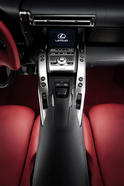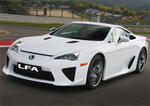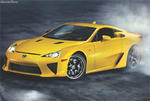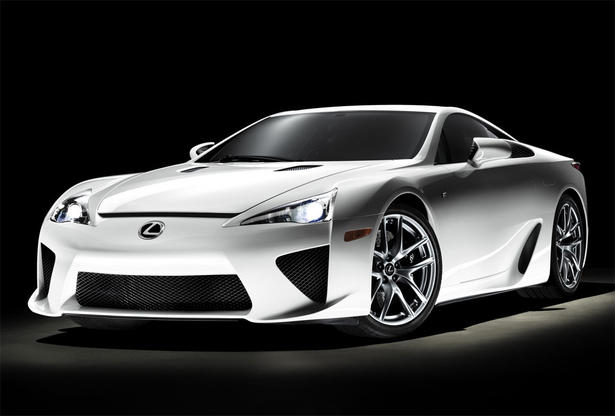
Lexus has finally unveiled their supercar - the Lexus LFA - at this year's edition of the Tokyo Motor Show. The Lexus LFA is powered by a 4.8 liter V10 engine that develops 552 bhp at 8,700 rpm and 480 Nm of torque at 6,800 rpm. The top speed of the Lexus LFA is 325km/h (202 mph) and the supercar is able to get from 0 to 100 km/h in 3.7 seconds. The engine of the Lexus LFA is coupled with a 6-speed automated sequential gearbox that send the power to the rear wheel through a limited slip differential. The weight distribution of the Lexus LFA is 48:52 front-to-rear. The Lexus LFA weighs 1,480kg which means it has a 373bhp per tonne power to weight ratio with a specific output of 115bhp per liter. This puts it among the highest of any current supercar. The company says the engine of the Lexus LFA is a
demonstration of compact and lightweight packaging, as its V10 engine is as big as a V8 and weighs as much as a regular V6. The power unit of the Lexus LFA has been developed in collaboration with Yamaha.
For a decreased weight, the chassis and bodywork of the Lexus LFA is made from Carbon Fiber Reinforced Plastic (CFRP), which is four times stronger than aluminum while being 100 kg lighter overall.
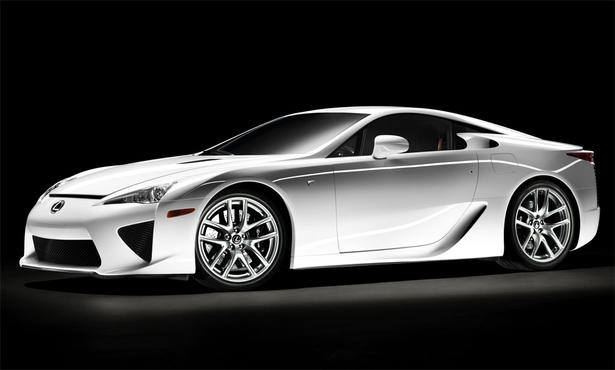
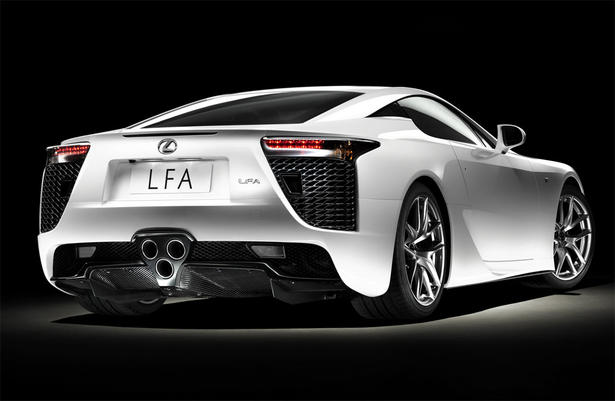
The company says it will only build 500 units of the Lexus LFA at a maximum rate of 20 per month. Each engine will be assembled by a single engineer, who will also sign it. The Lexus LFA price for the European market is 368,000 Euros, which means the price for UK is around 336,000 GBP.
Lexus Press Release:
INTRODUCTION
The new LEXUS LFA marks an important moment in both the history of Lexus and the development of
the supercar. A true “clean-sheet” design, the Lexus LFA was created by a small, passionate and dedicated team of engineers whose achievement has been to push the boundaries of technologies materials and engineering at every stage to produce a car like no other to have carried the Lexus badge.
Constructed using advanced carbon fiber technology, the rear-wheel drive Lexus LFA is powered by a bespoke, high-revving 552bhp 4.8-litre naturally aspirated V10 engine, matched to a rear-mounted
six-speed sequential automatic transmission, giving 200mph-plus performance.
In the words of Chief Engineer Haruhiko Tanahashi: “The Lexus LFA is a thoroughbred supercar, a machine engineered to achieve a single goal – to deliver a supreme driving experience. Over the past decade we have pushed every boundary in pursuit of this goal and I believe we have created the most driver-orientated car we possibly could.”
CARBON FIBRE CONSTRUCTION
Keeping the car’s weight to an absolute minimum was one of the defining elements in the development of the Lexus LFA and this led to the
decision to switch from using aluminum for the car’s construction to advanced Carbon Fiber Reinforced Plastic (CFRP) for the chassis and bodywork.
Moreover, Lexus decided the CFRP structure should be built in-house rather than by a third-party supplier. In doing so, it drew on Toyota Motor Corporation’s heritage in textile weaving technology to push the boundaries of its technical abilities, developing new carbon fiber looms and a laser system for monitoring the integrity of the material.
At four times the strength of aluminum, CFRP gives the Lexus LFA an exceptionally stiff and strong structure, and also delivers major weight advantages, saving around 100kg on an equivalent aluminum body. CFRP accounts for 65 per cent of the body-in-white, with aluminum alloy used for the remaining 35 per cent.
Unlike the few other vehicles on the market that use CFRP construction, the Lexus LFA uses the same advanced resin technology favored by cutting-edge aerospace programs for its unmatched weight and strength properties.
ENGINE
The heart of the Lexus LFA is a bespoke, naturally aspirated V10 engine that sets new standards for compact dimensions, lightweight architecture and scintillating performance. From the outset it was determined the engine should have a 4,805cc capacity, develop 552bhp and rev to a wailing 9,000rpm red line. A 72-degree angle between the cylinder heads is ideal for achieving balance in the engine for exceptionally smooth running, while providing individual, electronically controlled throttle bodies for each cylinder gives excellent throttle response.
Using a dry sump lubrication system allows the block to be positioned deep in the engine bay, lowering the car’s center of gravity and moment of inertia, and enabling the engine to handle sustained, high-speed cornering.
The V10 produces 480Nm of torque at 6,800rpm, 90 per cent of which is available from 3,700rpm all the way to the 9,000rpm red line, thanks to Dual VVT-i technology, equal length exhaust manifolds and high-volume, 12-hole fuel injectors. This gives searing in-hear acceleration at all engine speeds and in any gear: nought to 62mph takes just 3.7 seconds and maximum speed is 202mph.
With a kerb weight of 1,480kg, the Lexus LFA has a power to weight ratio of 373bhp per tonne, while specific output of 115bhp per liter is among the highest of any current supercar, aided by a high, 12:1 compression ratio, low friction internals and optimised intake and exhaust flow.
In spite of its potency, the V10 is an object lesson in compact and lightweight packaging, being about the same size as a regular V8 engine and weighing about as much as conventional V6. It is also as reliable and refined as any other Lexus power plan and exceeds Euro 5 emissions standards.
The engine was developed in conoctction with Yamaha through the established collaborative partnership between Toyota Motor Corporation and the Japanese specialist engineering company.
TRANSMISSION
The formidable performance of the V10 is managed through an equally advanced transmission, a purpose-designed six-speed Automated Sequential Gearbox (ASG) that drives the rear wheels via a limited slip differential. To help achieve the optimum 48:52 front-to-rear weight distribution, it is contained in a transaxle mounted over the rear axle.
The ASG is operated by paddle shifts mounted on the steering column and is engineered for exceptionally fast shifts: an upshift can be effected in just 0.2 seconds.
The system has four driving modes: Auto, Sport, Normal and Wet, activated by a selector dial on the dashboard. Each mode has a specific gearshift programme, and engine and brake control logic systems to let the driver tailor the car’s performance to suit driving conditions.
SOUND
The Lexus LFA’s acoustics, induction system and exhaust notes have been specially tuned to deliver an awesome “soundtrack” that expresses the car’s extreme performance, both outside and inside the cabin. Referred to by the acoustic team as “Octave Harmony”, it is inspired by the sound of a Formula 1 engine at full revs and is unlike that of any other road car, with different harmonic qualities created as the engine moves up towards its maximum 9,000rpm.
BRAKING
The Lexus LFA has one of the most advanced and powerful braking systems fitted to any production car, appropriate to meet the demands of its 200mph-plus performance capabilities.
The brake discs are made of Carbon Ceramic Material (CCM), which as well as being lighter than steel, gives fade-free performance in all conditions. The front discs are 390mm in diameter and 34mm thick, gripped by six-piston aluminium callipers; the rear discs measure 306mm across, are 28mm thick and are fitted with four-pot callipers. All use high-friction micron pads, manufactured exclusively for use with CCM brakes.
SUSPENSION, WHEELS AND TYRES
The track-tuned suspension is the result of intensive development work carried out by Lexus at the Nürburgring’s Nordschleife circuit to give the best possible balance between control and comfort.
The bespoke wishbone front/multilink rear design makes extensive use of aluminium alloy for high strength and low weight, and the aluminium monotube dampers are the same as those Lexus used for its Lexus LFA race car in the Nurburgring 24-hour race.
The 20-inch forged aluminium BBS wheels are shod with asymmetric Bridgestone tyres: 265/35ZR20 at the front and 305/20ZR20 at the rear.
AERODYNAMICS
The Lexus LFA boasts class-leading aerodynamics to achieve drivetrain cooling and superb high-speed handling and stability. Extensive wind tunnel testing helped produce a wind-cheating profile with a drag coefficient of 0.31, a remarkable achievement given the degree of downforce the car creates at high speed.
Airflow is precisely controlled over, under and around the car. A carbon fibre rear diffuser and flat underbody generate significant downforce, with an active rear wing, complete with a gurney flap on the leading edge, boosting the level further still.
STEERING
The race-tuned steering gives outstanding response and feedback to create a perfect dynamic link between car and driver. The constant-rate rack and pinion system uses an innovative column-assist Electric Power Steering System that does not sap engine performance.
The large-diameter column shaft is mounted directly on the central chassis structure, giving the steering layout exceptional rigidity. The carbon fibre steering wheel has a flat bottom section and houses the engine starter button and instrument information selector switch. It can be adjusted for reach and rake.
EXTERIOR DESIGN
Dictated by its front-mid engine layout, long wheelbase and short overhangs, sophisticated aerodynamics and low-slung cabin, the Lexus LFA’s lines flow from roof to sill in a seamless convex to concave line. As well as its low weight and high strength, carbon fibre reinforced plastic (CFRP) also gave the designers more freedom to create shapes, curves and edges that would have been impossible with metal.
The styling remains true, however, to the principles of L-finesse, the design rationale behind all current Lexus models. Form follows function, as witnessed n the numerous air intakes and aerodynamic details, and even in the design of the door mirrors, shaped to channel air over the car’s shoulders into the rear intakes.
INTERIOR DESIGN
The low-slung cabin is divided into three zones: the mechanical zone, which includes the skeleton of the car’s construction; the human zone, with two seats placed right at the centre of the car; and the driving zone, with high-tech instrumentation that brings driver and machine together.
The cabin is hand-built, with driver-focused ergonomics. The seats, upholstered in fine leather and Alcantara, provide the high level of back and side support needed in a car capable of 200mph-plus performance. The trim echoes the advanced materials used in the Lexus LFA’s construction, with exposed areas of both matt and gloss carbon fibre. Trim details are finished in brushed metal and the floor-hinged brake and throttle pedals are made of forged aluminium. As with the exterior finish, owners can choose different interior colours and details to suit personal taste.
INSTRUMENTATION
The compact, hooded instrument panel combines an LCD display panel with a colour Thin Film Transistor (TFT) and a motor-drive movable ring. It features a single circular dial with a central tachometer with an LCD needle. When engine speed exceeds 9,000rpm, the display area turns red to prime the driver for an up-shift. It can also be programmed to turn yellow or green when the revs reach a user-selected range. The dial also houses a digital speedometer and gear indicator, transmission mode, vehicle control data and trip information displays.
An information selector switch on the left side of the steering wheel lets the driver toggle through a series of functions, including customising the data display, adjusting cabin illumination and operating a track-ready stopwatch system.
When the car is started, an instrument display sequence is triggered, creating a sense of occasion, culminating in the four digital dials showing oil and water temperatures, fuel level and oil pressure radiating out from the centre of the rev counter to take up their positions on either side of the central dial.
SAFETY
Passive and active safety provisions are in line with the Lexus LFA’s exceptional performance. The central carbon fibre reinforced plastic central structure is extremely strong and provides excellent impact protection. Crash boxes are fitted front and rear that are designed to deform in a controlled fashion in the event of an impact. That at the front is made of CFRP; that at the rear from extruded aluminium. Side impact protection includes strong and rigid carbon fibre side members and door structures comprising an aluminium inner panel and a Glass fibre reinforced Sheet Moulding Compound (G-SMC) outer skin.
The Lexus LFA is equipped with Lexus’s Vehicle Dynamic Integrated Management (VDIM) system, which co-ordinates the smooth operation of the ABS, vehicle stability and traction control systems as the vehicle approaches its performance limits, based on critical data on brake operation, yaw and roll rates, individual wheel speed and longitudinal, lateral and vertical acceleration
Passive safety features include two-stage adaptive front airbags and seatbelt airbags for driver and passenger and a driver’s knee airbag.
MANUFACTURING AND SALES
The Lexus LFA programme was launched in 2000 as a straightforward R&D project, but gained impetus with the appointment of Haruhiko Tanahashi to lead a dedicated team of engineers, committed to a bespoke Lexus development programme. The first Lexus LFA prototype was completed in 2003 and a design study made its public debut at the 2005 Detroit motor show. In 2008 and 2009 the Lexus LFA was entered in the Nurburgring 24-hour race, the intention being to push the car hard under testing conditions prior to its official launch as a production-ready model at the 2009 Tokyo motor show.
The Lexus LFA will be hand-assembled at the Motomachi plant in Toyota City. Only 500 examples will be built, at a maximum rate of 20 per month to ensure the finest build quality and attention to detail. Each V10 engine will be assembled by a single engineer, and will bear his signature as testament to each Lexus LFA’s bespoke status.
The UK launch price for the Lexus LFA is €368,000 (approximately £336,000). Owners can choose from an extensive range of options to personalise their car, including 30 different paint finishes. Certain items of standard equipment can also be removed, such as the audio system, to reduce the car’s weight.
TECHNICAL SPECIFICATIONS
ENGINE
Engine Type
1LR-GSE
Cylinders/arrangement
V10
Valve mechanism
40-valve DOHC
Displacement (cc)
4,805
Bore x Stroke (mm)
88.0 x 79.0
Compression ratio
12.0:1
Fuel Injection Type
EFI,
Octane Rating
95 or higher
Max. Power (bhp @ rpm)
552 @ 8,700
Max Torque (Nm/rpm)
480 @ 6,800
Max. engine speed (rpm)
9,000
Exhaust emissions certification
Euro 5
PERFORMANCE
0-62mph (sec)
3.7
Max. speed (mph)
202
DIMENSIONS
Overall length (mm)
4,505
Overall width (mm)
1,895
Overall height (mm)
1,220
Wheelbase (mm)
2,605
Track (mm) front
1,580
Track (mm) rear
1,570
Overhang (mm) front
940
Overhang (mm) rear
960
Coefficient of Drag (Cd)
0.31
Fuel tank capacity (litres/gallons)
73/16.1
WEIGHTS (kg)
Kerb weight
1,480 – 1,580
Gross vehicle weight
1,700/1,750
TRANSMISSION
Gearbox type
6-speed Automated Sequential Gearbox
Front counter gear ratio
1.259
Gear ratios
1st
3.231
2nd
2.188
3rd
1.609
4th
1.233
5th
0.970
6th
0.795
Final drive ratio
3.417
Maximum permissible speed (mph)
1st
52
2nd
76
3rd
104
4th
136
5th
172
6th
-
BRAKES
Front – diameter x thickness (mm)
Cross-drilled ventilated discs, 399 x 34
Rear – diameter x thickness (mm)
Cross-drilled ventilated discs, 360 x 28
SUSPENSION
Front
Double wishbone with anti-roll bar
Rear
Multilink with anti-roll bar
STEERING
Steering gear type
Rack and pinion
Power steering type
Electric
Ratio
14.3
Turns lock to lock
2.35
ELECTRICAL SYSTEM
Battery capacity, voltage and Ampère hour
12V-48AH
Alternator output (W)
2,640
Starter output (kW)
1.7
TYRES AND WHEELS
Wheels
Front
20x9.5J BBS alloy
Rear
20x11.5J BBS alloy
Tyres
Front
265/35R20 95Y
Rear
305/30R20 99Y
LEXUS ANNOUNCES PRODUCTION OF Lexus LFA - ONLY 500 TO BE SOLD
Lexus has announced the official launch of the Lexus LFA, a two-seat supercar scheduled to go into production at the end of 2010, as the pinnacle of the Lexus "F" premium sports car series.
Pre-sales of Lexus LFA start today.
Ultra-responsive and extremely stable even when taken to the edge, the Lexus LFA creates a sense of reassurance that opens up a new world of driving emotion, exhilarating the senses to move the driver in more ways than one.
The Lexus LFA combines high output, superb chassis design and meticulous aerodynamics to achieve instantaneous total-vehicle response characterized by high-rev, seamless acceleration echoed by a self-defining resonance from its 4.8-litre V10.
Only 500 units of the Lexus LFA are to be produced and sold worldwide.
A prototype of the Lexus LFA is now on display at the 41st Tokyo Motor Show.
Vehicle Detail
1. Packaging brings out the most in fundamental performance
Strong and light
The newly developed 4.8-litre V10 engine boasts exceptional power, while lightweight materials (aluminum alloy, magnesium alloy and titanium alloy) and a very compact size (smaller than a conventional V8) allows for optimal weight distribution and an exceptional power-to-weight ratio.
Carbon fibre reinforced plastic (CFRP) cabin enhances high body-rigidity and reduces weight. This unique cabin is 100kg lighter than a comparable aluminum cabin. Detailed analysis and precise matching of CFRP materials allows for high rigidity and low weight. Lexus LFA CFRP production technology, including unique CFRP-to-metal joining, was completely developed by Lexus.
Balanced
Relatively higher weight components such as the engine and transmission are placed within the wheelbase. A low centre of gravity is made possible by the use of dry sump lubrication1, along with placing peripheral components (oil pump, water pump) behind the engine. Furthermore, optimal placement of the transmission and the fuel tank in front of the rear axle adds to this application of centralised mass.
This minimises weight shift during cornering and contributes to outstanding performance and stability. Lighter weight components, like the radiator and electric fans, are placed behind the rear axle.
Combined with a front-engine and rear-wheel-drive configuration, the short, wide and low body allows the Lexus LFA to achieve its target front-to-rear weight distribution of 48:52.
Driver-centred
The driver's seat is positioned near the Lexus LFA's centre of gravity. The centralised seating concept (with the seat between the front and rear axles and closer to the left-right centre) is made possible by the use of a rear transaxle and vertically stacked torque tube and exhaust pipes reducing the width of the centre tunnel. The driver placement is aimed to provide maximum car-to-driver feedback, especially under sport or high G-force driving conditions.
2. Emotive performance embodies an extraordinary driving experience
High-rev engine
Titanium valves, ultra-light weight rocker arms with a diamond-like coating and a fully integrated lower crankcase that reduces pumping losses at high RPMs combine to provide the driver with overwhelming acceleration right up to the 9,000rpm redline. The Lexus LFA's purpose-built V10 delivers 90% of its peak torque between 3,700rpm and 9,000rpm.
Precise Response
Independent, electronically controlled throttle bodies ensure precise air-feed to each of the 10 cylinders, enabling immediate engine response from the accelerator pedal. The engine response time is approximately half the normal response time of a single-throttle valve.
The six-speed Automated Sequential Gearbox (ASG) transmission features heavy-duty synchroniser rings and a newly developed gearshift actuator, providing the driver with a very direct shift feel. Four selectable driving modes and a seven-stage shift-speed selector that results in upshift speeds down to 0.2 seconds provide a higher level of driver control.
Track-sized high-performance (Carbon Ceramic) CCM brake discs and Electronically Controlled Braking system generate ultra-powerful yet stable braking.
Responsive handling and engaging dynamics
The very light and rigid CFRP cabin, combined with a front double-wishbone suspension and a rear multilink suspension, result in a very stable, controlled ride.
Detailed aerodynamic engineering results in elements such as a flat underbody, a diffuser and a speed-controlled rear wing, which allows precise vehicle response at all vehicle speeds, thus creating unity between driver and machine.
Vehicle Dynamics Integrated Management (VDIM) integrates numerous vehicle dynamic functions that provide a high level of vehicle stability and preventative safety without interfering with the driver's intentions, especially when sport driving.
Exciting engine sound and L-finesse2 design
Equal-length exhaust manifolds combined with an equal-length dual exhaust system routed through a multistage titanium main muffler fine tunes the exhaust note.
An acoustically tuned surge tank linked to 10 individual throttle bodies creates a powerful induction sound. The coordination of intake and exhaust sounds overlap at various RPMs to create a unique, exciting and inspired soundtrack.
The exterior design includes carefully tuned aerodynamics and airflow management. The use of CFRP, in addition to strength and weight advantages, frees up the design of the exterior panels allowing a fresh supercar L-finesse design. The interior design combines state-of-the-art instrument-panel design and technology, along with a variety of custom-tailored interior trim packages to suit the most discerning driver.



